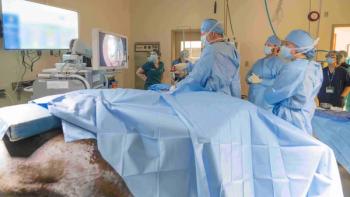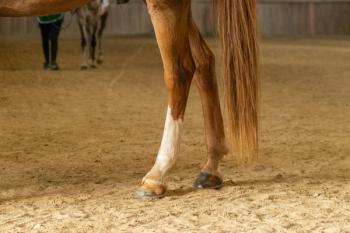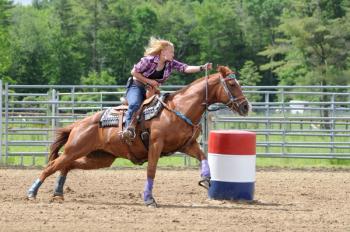
Equine intra-articular therapy (Proceedings)
Guidelines for equine intra-articular therapy
Therapeutic goals
• Eliminate lameness (pain)
• Disease modification
• Chondroprotection
What are we treating?
• Inflammation
• Mechanical stress
• Synovial fluid changes
• Cartilage pathology – breakdown
• Degenerative changes
Target areas for treatment
• Synovium
• Synovial fluid
• Articular Cartilage
• Sub-chondral Bone
Challenges of medical management
• Specific joint involved
• Stage of lesions
• Current and intended use of the horse
• Age of the horse
• Treatment cost
• Response to therapy
• Regulations
What we use
• Steroids
o Methylprednisolone acetate
o Triamcinolone
o Betamethasone
• Sodium hyaluronate
• Polysulfated glycosaminoglycans
• Interleukin-1 Receptor Antagonist
• Autologous Stem Cell
Corticosteroids
• Effects on Inflammation
o Inhibition of prostaglandin synthesis
o Phospholipase A2 inhibition
• Disease-modifying effects
o Inhibition of NF-κβ
o Decrease cytokine production
o Decrease IL-I, TNF α
o Inhibit MMP production
o Decrease fibrin deposition
• Effects of IA Corticosteroids on target Areas
o Synovium/Synovial Fluid
• Reduce synovitis
- Reduced synovial effusion (MPA) (Van Pelt RW. JAVMA 143:738-748, 1963)
- Decrease synovial membrane permeability (Eymontt et al. J Rheum 9:198-203 1982)
- Decreased total protein, increased viscosity, increased HA concentration (MPA) (Chunekamrai S et al. AJVR 50:1733-1741 1989)
• Inhibit interleukin-1 synthesis by synovial lining cells
• May improve cartilage nutrition by controlling severity of synovitis
- Enable return of normal synovial fluid properties
- Improve fluid exchange within the joint
• Increase proteoglycan concentrations (Roneus B et al. Zentralbl Veterinarmed; 40:10-16 1993)
• Increase in HA concentrations (Tulamo RM. AJVR; 52:1940-1944 1991)
o Cartilage
• Reduce matrix metalloproteinase activity in osteoarthritic cartilage in vitro (Richardson DW et al. Inflamm Res; 52:39-49 2003)
- Dose dependent
• Inhibit synthesis of metalloproteinase activators like plasminogen activator or plasmin
• Reduced cartilage damage in OA models in horses (Frisbie DD et al. EVJ 29:349-359 1997)
• Deleterious effects of steroids on cartilage:
- Inhibition of proteoglycan synthesis (Trotter et al. AJVR 52:83-87 1991)
- Dose dependent (Todhunter RJ et al J Rheum 23:1207-1213, 1996)
• Depresses total protein and collagen synthesis at high doses (Todhunter RJ et al J Rheum 23:1207-1213, 1996)
• Decrease in Safranin-O staining
- Estimate of matrix GAG content (Trotter et al. AJVR 52:83-87 1991)
• Decreased chondrocyte metabolism (Chunekamrai S et al. AJVR 50:1733-1741 1989)
• Chondrocyte necrosis and hypocellularity (MPA) (Chunekamrai S et al. AJVR 50:1733-1741 1989)
• Decreases in cartilage proteoglycan can be prolonged (Chunekamrai S et al. AJVR 50:1733-1741 1989; Trotter et al. AJVR 52:83-87 1991)
o Bone
• Most effects on bone are associated with systemic administration
- Adrenal suppression
• Decreases osteophyte formation and fibrillation (Williams JM et al; Arthritis Rheum 28:1267-1273 1985)
• Associated Complications of Steroid Use
o Steroid Arthropathy
• Defined as acceleration of degenerative changes within joint associated with steroid use
- Loss of joint space
- Instability of the joint
- Osteonecrosis
- Peri-articular osteophytosis
• Low incidence
- <1% in humans (Hollander JL. MD Med J; 19:62-66)
- May be progression of degenerative joint disease/osteoarthritis irrespective of steroid use
- Especially in cases where exercise is continued
o Post-Injection Flare
• Acute inflammatory response
- Synovial effusion
- Increased WBC
• Heat, pain, swelling, lameness
• 8-24 hours post-injection
• 2% incidence in people (Hollander JL MD Med J 19:62-66, 1970)
- Low incidence in horses (Pool RR et al Proc AAEP 26:397-415 1980)
- Up to 13 days post-injection
• Vehicle related
- Less prevalent with branched chain esters
o Potentiation of infection
• Signs not obvious immediately following injection
- Clinical signs masked for up to 3 days (Tulamo RM et al EVJ 21:332-337, 1989)
• Infections following steroid injections can be devastating
- Severe joint pathology
• Incidence unknown in horse
- Less than 1% in humans (Charalambous CP et al Clin Rheum 22(6):386-90, 2003)
- 12% in knee
o Laminitis and IA Steroids
• Triamcinolone acetonide
- Most often implicated
- Evidence of direct correlation is tenuous
• Retrospective analysis
o 0/201 horses treated with 40-80 mg doses
o 4/205 developed laminitis
o All 4 had prior history of laminitis
- Alters glucose metabolism = hyperglycemia (French et al. J vet Pharm Therap 23:287-292, 2000)
• Given IV or IM
o Effects persist
o 3-4 days at low dose (0.05 mg/kg)
o 8 days at high dose (0.2 mg/kg)
• Laminitis associated with altered glucose metabolism (Pass et al. EVJ suppl 26:133-138, 1998)
• Doseage Guidelines (whole-body dose)
o Triamcinolone < 18 mg
o Methylprednisolone acetate < 200 mg
o Betamethasone < 30 mg
• Potency per Unit Dose
o Flumethasone (most potent)
o Isoflupredone
o Betamethasone
o Triamcinolone
o Methylprednisolone (least potent)
• Duration of Action
o Short-acting Corticosteroids
• Hydrocortisone, Flumethasone
o Longer-acting Corticosteroids
• Triamcinolone, Betamethasone, Methylprednisolone acetate
o Water solubility is irrelevant
o Rate of hydrolysis of ester is critical
• Triamcinolone acetonide
o Medium length intra-articular half-life (1-5 days)
o 6-12 mg/joint
o 18 mg total body dose
o Has shown the most positive effects of the steroids studied
• In vitro (Richardson DW et al. Inflamm Res; 52:39-49 2003)
- Inhibit synthesis of MMP and other proteinases
• In OCF model (Frisbie DD et al. EVJ 29:349-359 1997)
- Minimized development of OA
• Methylprednisolone acetate (Depo-Medrol)
o Dose dependent balance between combating inflammation, yet maintaining healthy joint environment
o 10 - 40 mg / joint
o Long acting (intra-articular half-life 1 month)
o 120 mg total body dose
• Betamethasone (Betavet)
o Potent
o Medium to long duration of action
o 16 mg/joint (Foland JW et al. Vet Surg 23:369-376 1994)
• In exercised and non-exercised horse no deleterious affects on cartilage in OCF model
• Can affect proteoglycan synthesis at low doses (Frean SP et al J Vet Pharm and Ther; 25:289-298 2002)
o 30 mg total body dose
• Steroid Application
o Choose wisely
o Low dose
• Most affects are in high-dose models
o Rest after use
• 24 hours in human patients prolongs response (Chakravarty K et al Br J Rheumatol 33:464-468 1994)
• Impact of exercise on compromised joint
o Limit repeated doses
• More effects observed in studies with repeated doses
• Where are we now in regards to steroid use?
o Low doses of corticosteroids have chondroprotective properties without marked deleterious effects on chondrocytes
o Still have much to learn
• Dose?
• Frequency of administration?
• Enhance efficacy if combined with HA or growth factor therapy?
Sodium hyaluronate
• Hyaluronic Acid
o HA = hyaluronan = hyaluronic acid
o Long unbranched nonsulfated glycosaminoglycan
o Synthesized by
• Type B synoviocytes
• Chondrocytes
- Component of extra-cellular matrix
o Functions within the joint:
• Viscoelasticity of joint fluid
• Boundary lubrication
• Modulates chemotactic response
• Sodium Hyaluronan (HA)
o Linear polydisaccharide
o Original concept - viscosupplementation
o Most effective in treatment of acute synovitis
o Mechanisms remain unclear
• Anti-inflammatory effects
- Suppression of cytokines and proteinases (Takahashi K et al. Osteoarthritis Cartilage; 7:182-190 1999)
• Stimulation of endogenous HA production
o Mechanisms of action
• Steric hindrance
• Scavenge free radicals
• Reduction of bradykinin and prostaglandin
• Increase in endogenous HA synthesis via cAMP levels
o HA Choices
• Does size matter?
- Hylartin V (3.5,000,000 Da)
- Legend (1,000,000 Da)
- Hyvisc (1,000,000 Da)
- Hyalovet (400,000 Da)
- Synacid (150,000 Da)
• Conflicting evidence
- Differences between in vivo and in vitro work
- Difference between studies using OA models
• Recommendation is to use products between 500,000 and 2,000,000 Da MW
o Combination Treatment
• With steroids:
- Synergistic beneficial effect
- More long-lasting clinical effect (Rydell NW et al. Acta Vet Scand 11:139-155 1970)
- Combination helps prevent changes associated with steroids (Roneus B et al Zentralbl Veterinar med A 40:10-16 1993)
Polysulfated glycosaminoglycan (Adequan)
• Semi synthetic preparation of bovine trachea
o Composed primarily of chondroitin sulfate
• Stimulation of production of HA (synoviocytes)
• ±Increase synthesis of proteoglycans and collagen by chondrocytes
• Inhibit degradative enzymes
o nMMP
o Plasminogen activators
o Lysosomal elastase
o Cathepsin
• Adverse Effects of PSGAG
o Increases activated partial thromboplastin, prothrombin, and activated clotting times in dogs at 5 and 25 mg/kg (Beale et al., 1990)
o Thrombocytopenia (human)
o IA use: Increased minimum inhibitory concentration of antibiotics effective in vitro against S. aureus (Gustafson et al., 1989)
Interleukin-1 receptor antagonist (IRAP)
• Autologous Conditioned Serum
o Interleukin-1 Receptor Antagonist
• Competes with Interleukin-1 for binding
• Prevents activation of receptor
• Experimental evidence for decreasing joint inflammation is strong
o Increase IRAP in serum by incubation with chromium beads
• Stimulate monocytes (human)
- ↑ IRAP_____140x
- ↑ IL-4, IL-10___2x
- IL-1β, TNF-α__0x
• Improved lameness
• Decreased synovial membrane hyperplasia
• Better for acute synovitis
• Levels of IRAP???? Cost!
• Carpal chip model of OA
o IL-1 Ra level increased after processing:
• 234 pg/ml v. 45 pg/ml
o Improved histologic score
o Synovial fluid IL-1 Ra increased over time
• Stimulates endogenous production of IL-1 Ra
Autologous stem cells
• Cell-based Therapies
• Direct injection of cells
o Nucleated cell fraction from adipose tissue (VetStem)
o Cultured bone marrow mesenchymal stem cells
• VetStem
o Joint Injection
• 56.7% (34/60) returned to full work at prior level and 26.7% (16/60) returned to full work at a reduced level
• 50/60 back in work
Newsletter
From exam room tips to practice management insights, get trusted veterinary news delivered straight to your inbox—subscribe to dvm360.




